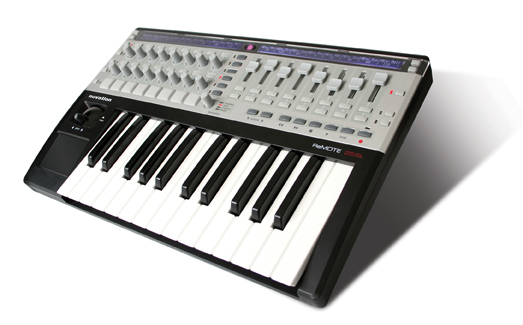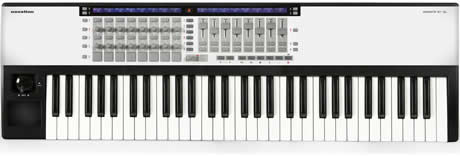Novation Remote 61SL

It’s not often you find a product changing the way you work, normally you pick something you expect to fit in with your workflow and go with it. Being a journalist I end up trying products I would not normally consider for purchase and just occasionally I find them becoming irreplaceable.
The Novation Remote 61SL is one such product. As an owner of a Roland Fantom X8 I was heading down the road of live audio recording from hardware synthesizers, but this posed two problems that I did not fully recognise until getting my hands upon the Novation Remote 61SL
The first problem is the accessibility of arranging software when using an all-in-one workstation solution like the Fantom X8, because the hardware synthesizer is so heavily geared toward playing live I found myself doing just that and committing very little to my software arranger. The second is the sheer behemoth size and lack of portability that the oh-so-wonderful Fantom X8 is cursed with.
The Novation 61SL addressed both of these problems, with sound being produced entirely in software I found myself recording more and playing about with sounds less and because the Novation 61SL can be powered entirely by USB I found myself sitting in the most unlikely of places composing music where otherwise I would be twiddling my fingers or doing something else simply because I didn’t want to consign myself to the room dedicated to the Fantom- I composed in armchairs, on the dining table and in bed… and I only had to lug the Remote 61SL, my MacBook Pro and one power cord with me to do so.
Suffice to say, the Novation 61SL prompted my move from hardware to software synthesis, in retrospect any control surface could have done the same but I’m not entirely convinced they would all have done as well.
First and foremost the Novation Remote 61SL is extremely easy to set up and use. You take your computer and the keyboard and connect the two with a USB cable. That’s it. In Mac OS X 10.5 there was no need for driver installation and I was playing a soft-synth in seconds.
If you want to install the included software, however, the 61SL becomes a whole lot more powerful and complex
I was quite stunned that the 61SL was capable of being powered over USB, it’s no small control surface by any stretch of the imagination and is not light either. There’s the option of a mains adaptor if you wish to use the 61SL to control hardware synths but it’s so well geared toward software such as Reason and Cubase that it would seem overkill to do so.
Secondly; The 61SL is absolutely loaded with an overwhelming array of controls, this can be both a good and bad thing depending on how you look at it. There are, indeed, far more controls than I would normally use, particularly when parameter automation can be edited manually into tracks, but there’s no conceivable way I could turn this into a complaint.

Strikingly the 61SL boasts two wide 144 character LCD screens, of a size you don’t normally even see on hardware synths, that effectively act as dynamic labels for the onboard controls. This is essential if you opt to install the included software and make use of the advanced features of the 61SL. Each control can potentially be mapped to a software instrument parameter by Novation’s Automap Universal software and the function it’s mapped to displayed so you know what it is at a glance. Reason with all its instruments, effects and the mixer is supported by this feature allowing the 61SL to offer an unprecedented level of control over it with very little setup. The transport controls are the icing on the cake and something no control surface should be without; the ability to Rewind/Fast Forward/Stop/Start/Record and toggler Looping without reaching for a keyboard and mouse is essential.
The key-bed itself is semi-weighted, which is something I have never quite understood in controllers, playing quickly and manually is considerably easier and more comfortable on a non-weighted keybed and I’ve never found the semi-weighted feel to even come close to the quality you would find on a properly weighted and graded action key-bed. Still, it’s certainly not bad and it can be argued that a semi-weighted key-bed allows for slightly more expressive playing albeit this is only useful when playing software instruments that benefit from that expression and when you’re not simply normalising the velocity of each note. The key-bed also boasts aftertouch, the ability to alter the sound being played by a depressed key by varying the pressure applied to that key, which is a definite must-have if only because there’s no sense and no benefit in not including it.
The most notable controls on the 61SL are the lovely vector joystick which gives you fluid movement on an X-Y axis normally controlling pitch/modulation but assignable to any soft-synth parameter you can imagine, and if that isn’t enough there’s also a touch sensitive X-Y pad which is something I absolutely adore for doing fluid sweeps across two different filter parameters. Whilst you can edit these into your finished track as vector paths there’s nothing more rewarding than listening to your synth melody build into a chorus cacophony as you sweep the cut-off and reverb simultaneously with one finger. Combine both the X-Y pad and Joystick over a pre-recorded melody and you’re effectively and precisely moving what would otherwise be 4 knobs with just two fingers and a thumb. In short, if you love your electronic music then the pad/stick combo is extremely effective, far more so than Roland’s often single axis D-Beam. I wonder how long until someone produces a vector joystick we can also twist? Or is that going too far.
As a 61 key control surface the Remote 61SL is somewhat bulky, and the semi-weighted key-bed gives the unit a significant heft compared to most control surfaces you would consider portable. Never-the-less it’s trivial to tuck the 61SL under one arm and a laptop/power cable under the other to move around the house if you like a little company when composing or simply want to relocate somewhere comfortable.
Now, I’ve focussed quite heavily on the 61SL as a portable, USB-connected soft-synth control surface but it also carries two MIDI outputs, one input and a MIDI through port allowing you to use it as a master controller for an array of hardware synthesizers. There are also inputs for sustain and expression pedals.
It’s size and weight suggest that the 61SL is best used in this role, as a stationary control surface connected to a software or hardware synthesizer but the very fact it still shines as a portable and runs on power from a single USB port makes it fantastically giggable. The 61SL, in lieu of something like the Roland Juno D or G, can be tossed into a gig bag along with a laptop which, if loaded with enough software, can provide a stunning variety of sound with no weak points and absolutely no compromises. This, in effect, gives you a better setup than the Fantom X6 by leaps and bounds with the possibilities in software being almost limitless and the benefits of an industry standard software arranger such as Cubase being clear to all. How long, I wonder, before someone simply takes a laptop computer, a good control surface and combines the two into the most flexible and powerful portable all-in-one synthesis solution ever imagined? Korg are half way there with the Oasys but, for now, if you want to go all the way the only choice is a good quality control surface such as the Novation 61SL.